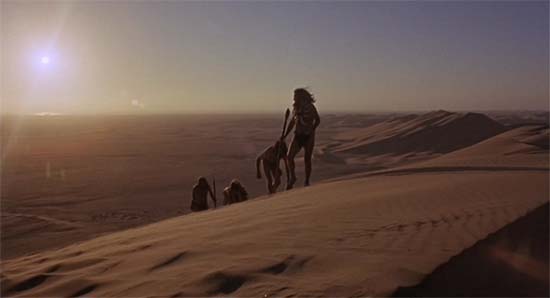 Hammer Films scored one of its greatest successes with One Million Years B.C. (1966), a one-off collaboration with stop-motion special effects master Ray Harryhausen. The film was notable to fantasy film enthusiasts both for Harryhausen’s dinosaur creations and for its iconic, much-imitated poster: a tanned and fit Raquel Welch striking a pose in a fur bikini. Never to let a successful effort go uncloned, Hammer quickly established its own prehistoric adventure subgenre, including Slave Girls (aka Prehistoric Women, 1967) and the (improbably) Oscar-winning When Dinosaurs Ruled the Earth (1970). The exploitation elements were simple and straightforward: dinosaurs (if they could afford them), exploding volcanoes, and attractive actresses in bikinis, grunting a lot. Something for the kids, and something for Dad. Everybody’s happy…for a while.
Hammer Films scored one of its greatest successes with One Million Years B.C. (1966), a one-off collaboration with stop-motion special effects master Ray Harryhausen. The film was notable to fantasy film enthusiasts both for Harryhausen’s dinosaur creations and for its iconic, much-imitated poster: a tanned and fit Raquel Welch striking a pose in a fur bikini. Never to let a successful effort go uncloned, Hammer quickly established its own prehistoric adventure subgenre, including Slave Girls (aka Prehistoric Women, 1967) and the (improbably) Oscar-winning When Dinosaurs Ruled the Earth (1970). The exploitation elements were simple and straightforward: dinosaurs (if they could afford them), exploding volcanoes, and attractive actresses in bikinis, grunting a lot. Something for the kids, and something for Dad. Everybody’s happy…for a while.
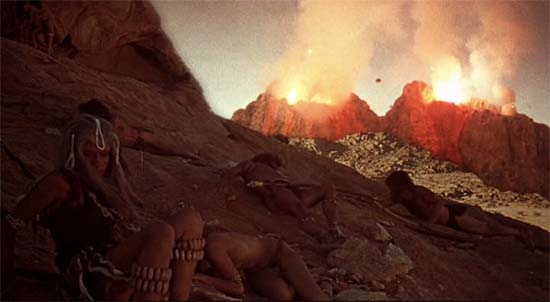 Because by the time Creatures the World Forgot arrived, it should have been pretty clear that the genre was running dry, and becoming increasingly pointless. First: a few pluses. Director Don Chaffey returns, having helmed the Welch/Harryhausen vehicle that started the craze. Chaffey had a long and busy career in films and television, and his resume includes cult classics (such as 1963’s Jason and the Argonauts and episodes of the seminal TV series The Prisoner) and paycheck-cashing, defeated sighs (like 1979’s bizarre kiddie flick C.H.O.M.P.S.). No matter what work he was given, Chaffey treated it with great seriousness, and this proud work ethic is clearly on display in Creatures the World Forgot. He gets the job done competently. He works extra hard to get past the limitations of the actors speaking no English, and relies upon visual storytelling, like a silent film augmented by lots of grunting. The film looks gorgeous; shot on location in Africa, it appropriates the local wildlife and some spectacular scenery, including a trek through desolate sand dunes, and action staged around giant round boulders which, though part of the natural landscape, look like a Surrealist painting. Chaffey also downplays the exploitation elements as much as possible, and though I’m not sure how writer/producer/studio exec Michael Carreras felt about this (I suspect there might have been some mild creative disagreements, but will leave it to the Hammer scholars out there to inform me), this is not a “sexy” film by any means; quite the opposite. The cheesecake has been replaced by an anthopological seriousness which may have been influenced by the “Dawn of Man” sequence in 2001: A Space Odyssey (1968). But Creatures is certainly not as rigorously informed. This is just a prehistoric survival adventure. Was it a wise decision to play it like a National Geographic special, or a severe folly?
Because by the time Creatures the World Forgot arrived, it should have been pretty clear that the genre was running dry, and becoming increasingly pointless. First: a few pluses. Director Don Chaffey returns, having helmed the Welch/Harryhausen vehicle that started the craze. Chaffey had a long and busy career in films and television, and his resume includes cult classics (such as 1963’s Jason and the Argonauts and episodes of the seminal TV series The Prisoner) and paycheck-cashing, defeated sighs (like 1979’s bizarre kiddie flick C.H.O.M.P.S.). No matter what work he was given, Chaffey treated it with great seriousness, and this proud work ethic is clearly on display in Creatures the World Forgot. He gets the job done competently. He works extra hard to get past the limitations of the actors speaking no English, and relies upon visual storytelling, like a silent film augmented by lots of grunting. The film looks gorgeous; shot on location in Africa, it appropriates the local wildlife and some spectacular scenery, including a trek through desolate sand dunes, and action staged around giant round boulders which, though part of the natural landscape, look like a Surrealist painting. Chaffey also downplays the exploitation elements as much as possible, and though I’m not sure how writer/producer/studio exec Michael Carreras felt about this (I suspect there might have been some mild creative disagreements, but will leave it to the Hammer scholars out there to inform me), this is not a “sexy” film by any means; quite the opposite. The cheesecake has been replaced by an anthopological seriousness which may have been influenced by the “Dawn of Man” sequence in 2001: A Space Odyssey (1968). But Creatures is certainly not as rigorously informed. This is just a prehistoric survival adventure. Was it a wise decision to play it like a National Geographic special, or a severe folly?
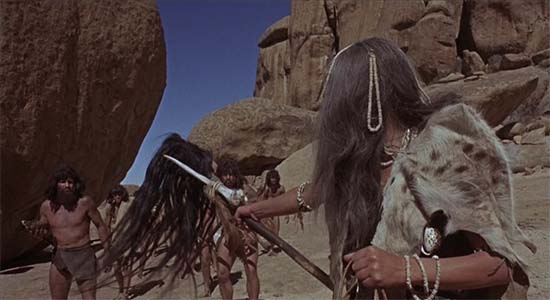 This isn’t 2001, and it’s not Quest for Fire (1981) either. The quasi-epic plot covers two generations of a prehistoric tribe, first fleeing from their homeland after it’s destroyed by a volcano, then attempting to survive in a parched desert landscape, and squabbling over who should lead them. Midway through the film, two sons are born (ominously, the mother dies in childbirth): one blond and good, the other brunette and eeeevil. An omen (lightning striking a tree) leads the tribe’s female shaman to determine that the blond child will be their future chieftain, and so she marks him with a scar upon his chest. There’s some more squabbling…quite a bit of squabbling, actually. Eventually they discover a pretty cavegirl played by Julie Ege, who becomes an object of jealousy; in a scene strangely reminiscent of the climax of Supervixens, she’s tied up at the top of a mountain, and our blond hero must fight to rescue her. I have to tell you, the ending to Supervixens is a lot more entertaining, mainly because Charles Napier goes crazy and starts chucking sticks off dynamite at the good guy. But any given minute of a Russ Meyer film is more entertaining than the whole of Creatures the World Forgot.
This isn’t 2001, and it’s not Quest for Fire (1981) either. The quasi-epic plot covers two generations of a prehistoric tribe, first fleeing from their homeland after it’s destroyed by a volcano, then attempting to survive in a parched desert landscape, and squabbling over who should lead them. Midway through the film, two sons are born (ominously, the mother dies in childbirth): one blond and good, the other brunette and eeeevil. An omen (lightning striking a tree) leads the tribe’s female shaman to determine that the blond child will be their future chieftain, and so she marks him with a scar upon his chest. There’s some more squabbling…quite a bit of squabbling, actually. Eventually they discover a pretty cavegirl played by Julie Ege, who becomes an object of jealousy; in a scene strangely reminiscent of the climax of Supervixens, she’s tied up at the top of a mountain, and our blond hero must fight to rescue her. I have to tell you, the ending to Supervixens is a lot more entertaining, mainly because Charles Napier goes crazy and starts chucking sticks off dynamite at the good guy. But any given minute of a Russ Meyer film is more entertaining than the whole of Creatures the World Forgot.
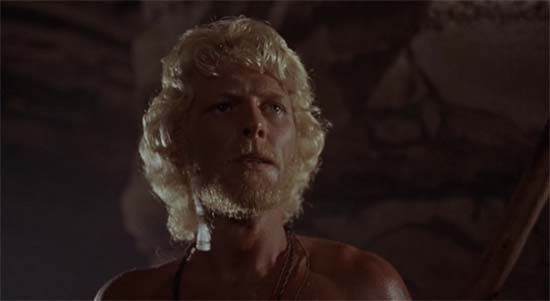 The film has noble intentions, but it seems like a wasted effort. Because it does not seem to have any kind of anthropological veracity, we’re treated to scene after scene which is not terribly enlightening. Which is to say, it appears to be written by Michael Carreras, not Arthur C. Clarke. It’s a pulp adventure film, and everybody knows it. So your enjoyment is based solely on whether or not you want to see this kind of cheesy pulp adventure with an extra layer of grit: a tribesman picking up a scorpion, ripping off its tail, and chowing down; painful childbirth in the wild; a weird scene in which the young bad guy assaults a girl with a live porcupine in his hands. There’s nudity in the film (Hammer was beginning to make it a prerequisite at the dawn of the 70’s, as a marketing tool), but again I wonder if there weren’t some Carreras/Chaffey conflict of interest here. Chaffey refuses to make a leering cheesecake film like When Dinosaurs Ruled the Earth; he de-eroticizes the fleeting nudity, and refuses to let his camera linger upon it; there’s plenty of skin, but he cakes it down with mud and dirt, or covers it with necklaces of warthog-tusks. Thing is, though, When Dinosaurs Ruled the Earth, for all its campiness, is a lot more entertaining than this film. Creatures the World Forgot just isn’t very fun at all.
The film has noble intentions, but it seems like a wasted effort. Because it does not seem to have any kind of anthropological veracity, we’re treated to scene after scene which is not terribly enlightening. Which is to say, it appears to be written by Michael Carreras, not Arthur C. Clarke. It’s a pulp adventure film, and everybody knows it. So your enjoyment is based solely on whether or not you want to see this kind of cheesy pulp adventure with an extra layer of grit: a tribesman picking up a scorpion, ripping off its tail, and chowing down; painful childbirth in the wild; a weird scene in which the young bad guy assaults a girl with a live porcupine in his hands. There’s nudity in the film (Hammer was beginning to make it a prerequisite at the dawn of the 70’s, as a marketing tool), but again I wonder if there weren’t some Carreras/Chaffey conflict of interest here. Chaffey refuses to make a leering cheesecake film like When Dinosaurs Ruled the Earth; he de-eroticizes the fleeting nudity, and refuses to let his camera linger upon it; there’s plenty of skin, but he cakes it down with mud and dirt, or covers it with necklaces of warthog-tusks. Thing is, though, When Dinosaurs Ruled the Earth, for all its campiness, is a lot more entertaining than this film. Creatures the World Forgot just isn’t very fun at all.
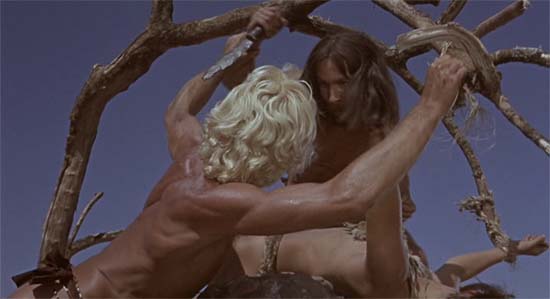 The title, of course, is misleading. There aren’t any dinosaurs (sorry, Creationists), and the only beastie, apart from the native animals of Africa who put in cameo appearances, is a cave bear which is quite obviously a man in a cheap costume. A more accurate title would have been “Creatures the Film Forgot.” It doesn’t help that the poster prominently features Julie Ege, even though she hardly appears in the film at all, and boasts the tagline: “SEE the sensational new star Julie Ege. She’s a creature you’ll never forget!” So…hey, chaps…who needs dinosaurs? We’re all men, aren’t we?
The title, of course, is misleading. There aren’t any dinosaurs (sorry, Creationists), and the only beastie, apart from the native animals of Africa who put in cameo appearances, is a cave bear which is quite obviously a man in a cheap costume. A more accurate title would have been “Creatures the Film Forgot.” It doesn’t help that the poster prominently features Julie Ege, even though she hardly appears in the film at all, and boasts the tagline: “SEE the sensational new star Julie Ege. She’s a creature you’ll never forget!” So…hey, chaps…who needs dinosaurs? We’re all men, aren’t we?
I will say this: of all the films Hammer released in 1971, this one, cave bear suit notwithstanding, has the most expensive look, largely due to the spectacular locations. But this kind of film either needed more credibility (Quest for Fire), or just campy parody (1981’s Caveman). Hammer would desperately look to exploit more trends, but for this studio, the smoking volcano was already on the horizon.









